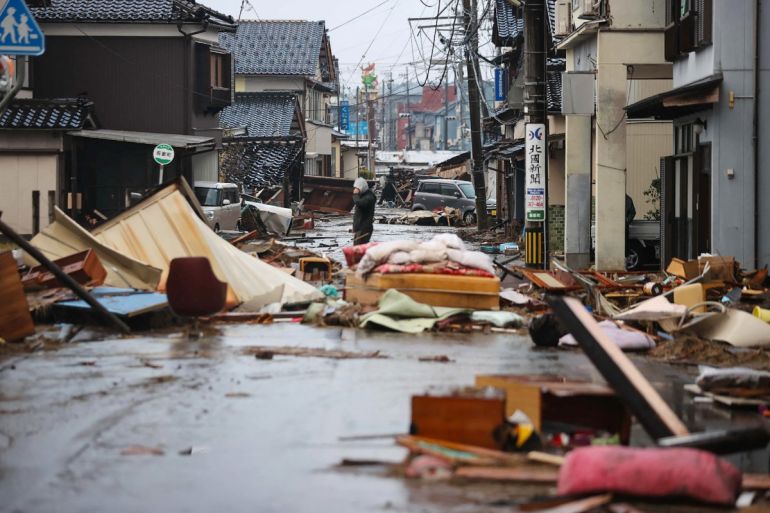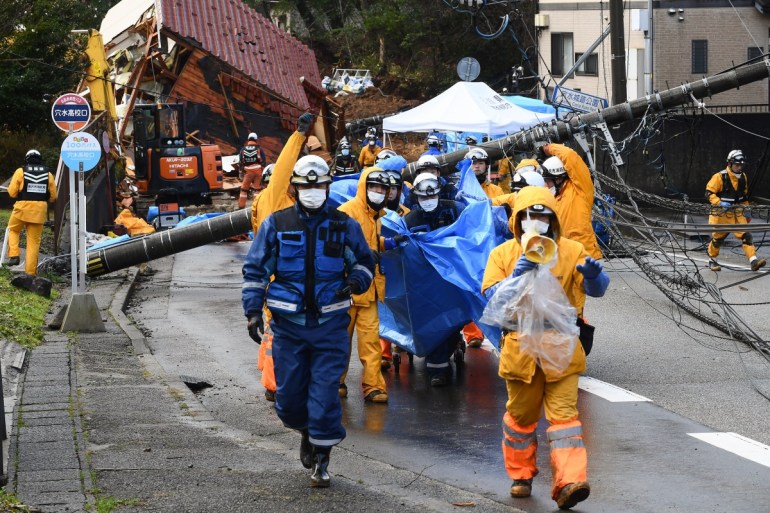Japan earthquake death toll crosses 100
Hundreds of people are still missing after a magnitude 7.6 earthquake struck Japan’s west coast on January 1.

The death toll from Japan’s New Year’s Day earthquake has now exceeded 100, as rescuers and residents have been sifting through the rubble to recover bodies.
Hopes have dimmed to find survivors following the country’s deadliest earthquake in nearly eight years. But the authorities said on Saturday that more than 200 people are still missing.
Keep reading
list of 3 itemsPhotos: Aftermath of devastating earthquake in Japan
Japan races to find earthquake survivors five days on
The magnitude 7.6 earthquake that struck Japan’s west coast destroyed infrastructure, leaving 23,000 homes without power in the Hokuriku region.
Sixteen further deaths were confirmed in Wajima city and Anamizu town by 1pm (04:00 GMT) on Saturday, bringing the total to 110, the Kyodo news agency reported, quoting the Ishikawa prefectural government and other sources.
Wajima city has recorded the highest number of deaths with 59, followed by Suzu with 23. The disaster resulted in more than 500 injuries, at least 27 of them serious.

“I was relaxing on New Year’s Day when the quake happened. My relatives were all there and we were having fun,” Wajima resident Hiroyuki Hamatani, told the AFP news agency amid charred cars and fallen telegraph poles.
“The house itself is standing but it’s far from livable now … I don’t have the space in my mind to think about the future,” the 53-year-old said.
Four of the world’s tectonic plates meet in Japan making the country particularly prone to earthquakes. It experiences hundreds of tremors every year, but most cause little to no damage.
The death toll from last week’s earthquake is the highest since 2016, when quakes in Kumamoto, southwestern Japan, killed 276 people.
In 2011, a magnitude 9 undersea earthquake triggered a massive tsunami that wiped out entire communities and caused a meltdown at the Fukushima nuclear plant. At least 18,500 people were killed.
Relief operations ongoing
Thousands of soldiers were flying and trucking in water, food and medicine to the more than 32,000 people who had evacuated to auditoriums, schools and other facilities.
However, road disruptions and other problems have hindered the delivery of relief supplies.
“We are doing our best to conduct rescue operations at the isolated villages … However, the reality is that the isolation has not been resolved to the extent that we would like,” Ishikawa governor Hiroshi Hase said on Friday.
The Yomiuri newspaper reported more than 100 landslides in the area, some blocking essential roads.
While power is gradually returning along the coastline, water supplies remain scarce, with damaged emergency water systems.
In an unusual gesture from nearby North Korea, leader Kim Jong Un sent a message of condolence to Japanese Prime Minister Fumio Kishida, the Korean Central News Agency reported on Saturday.